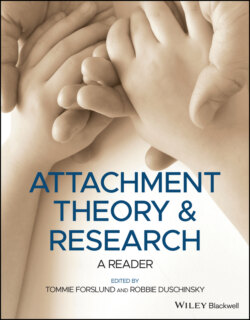Читать книгу Attachment Theory and Research - Группа авторов - Страница 31
Notes
Оглавление1 1 [Eds. Cannon, W. B. (1932). The wisdom of the body, NY: Norton.]
2 2 [Eds. Some of the ideas presented here would later appear, in abreviated form, in the two‐page section ‘Maintaining a stable relationship with the familiar environment: a form of homeostasis' in Chapter 9 of Bowlby, J. (1973) Separation, London: Pimlico.]
3 3 [Eds. The following text was located at the very end of Bowlby's manuscript notes, with the prefix “8A”. Since it fits with the theme discussed here, and the authors that are referenced, it may have been meant as an addition to, or as an alternative to, the current paragraph. Alternatively, at least one manuscript page is missing since the text would start mid‐sentence. “Menninger (1954, 1963). Other and quite different versions have been formulated by Engel (1963, 1962) and by Sandler and Joffe (Joffe & Sandler, 1968; Sandler & Joffe, 1969). In the Engel version, the parameter held constant is the ‘stability of the ego' or ‘intactness of the psychic self', the maintenance of which persisting interaction with (what is here termed) the personal environment is believed to be essential. In the Sandler–Joffe version the parameter held constant or above a minimum level is conceived as a ‘feeling of safety' or well‐being. Within the sequence advanced here Engel's ‘stability of the ego' is regarded as a product of the successful maintenance of personal environmental and representational homeostasis, whilst Sandler's ‘feeling of safety' is regarded as an indication of the extent to which all of the various categories of homeostasis under consideration are being successfully maintained. Formulations regarding quantities of psychical energy or levels or tension are not found useful.”]
4 4 [Eds. Festinger, L. (1957). A theory of cognitive dissonance, Stanford: Stanford University Press.]
5 5 [Eds. Kuhn, T. (1963) Structure of scientific revolutions, Chicago: University of Chicago Press.]
6 6 [Eds. Jackson, D. D. (1957) The question of family homeostasis. Psychiatric Quarterly, 31 (1), 79–90.]
7 7 [Eds. The reference is likely to Edwin Lawson, though exactly which text was meant by Bowlby is unclear. Lawson's only publication of 1963 was Lawson, E. D. (1963). Development of patriotism in children – a second look. The Journal of Psychology, 55 (2), 279–286.]
8 8 [Eds. Wynne‐Edwards, V. C. (1962). Animal dispersion in relation to social behavior. Edinburgh: Oliver and Boyd.]
9 9 [Eds. Waddington, C. H. (1957) The strategy of genes. London: Allen & Unwin.]
10 10 In physics any condition causing a stress is commonly termed a ‘load', though ‘stressor' would be equally appropriate. A review of current usage in different fields of the term ‘stress' is given by Richter [Eds. Richter, D. (1960). Some current usages of the word “stress” in different fields. In Tanner, J. M. (Ed.), Stress and psychiatric disorder, Oxford: Blackwell, pp. 31–33].
11 11 [Eds. Selye, H. (1950). Stress and The General Adaptation Syndrome. The British Medical Journal, 1383–1392.]
12 12 The Oxford English Dictionary (1916) gives as the second meaning of ‘trauma' (derived from psychoanalysis): “a disturbing experience which affects the mind or nerves of a person so as to induce hysteria of ‘psychic conditions'; a mental shock”.
13 13 In expressing that view, the existence of opposite tendencies follows.
14 14 The concept of personal environmental homeostasis is distinct from and much broader than that of territoriality. Whilst very many species of bird and mammal show marked preference for a particular home range and particular companions (see Jurell & Loizos, 1966), far fewer maintain and defend an exclusive territory. [Eds. Jewell, P. A., & Loizos, C. (1966). Play, exploration and territoriality in mammals (p. 18). London: Symposia of the Zoological Society]
15 15 [Eds. Some of this section is draw upon in Bowlby, J. (1973) Separation, London: Pimlico, Appendix III ‘Problems of terminology'.]
16 16 [Eds. Onions, C. T. (1966). The Oxford dictionary of English etymology. Oxford: ClarendonPress.]
17 17 [Eds. Lewis, A. ( 1967). Problems presented by the Ambiguous Word “Anxiety” as used inPsychopathology. Israel Annals of Psychiatry & Related Disciplines 5: 105–21.
18 18 [Eds. Freud, S. ([1926] 2001) Inhibitions, symptoms, and anxiety. Standard Edition, 20:87–156.London: Hogarth Press, pp.136–7.]
19 19 [Eds. Onions, C. T. (1966). The Oxford dictionary of English etymology. Oxford: ClarendonPress.]
20 20 Sandler (1960) uses the term ‘feeling of safety' as equivalent to any feeling of security, which is etymologically better suited. Sandler does not discuss how this ‘feeling of safety' is related to actual safety. [Eds. Sandler, J. (1960). The background of safety. International Journal of Psycho‐Analysis, 41, 352–356.]
21 21 [Eds. The quote is from the ‘to be, or not to be' soliloquy by Hamlet, in Shakespeare's Hamlet, Act 3, Scene 1.]
